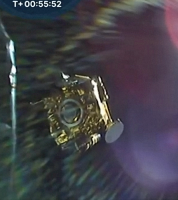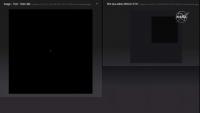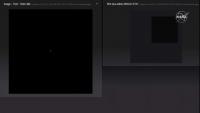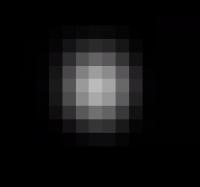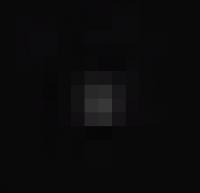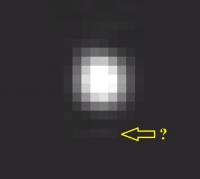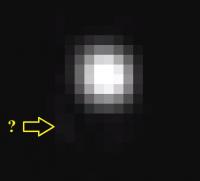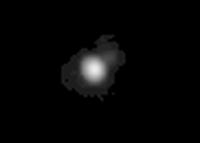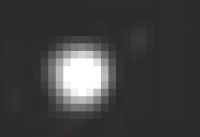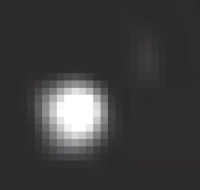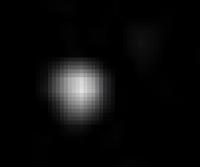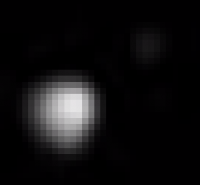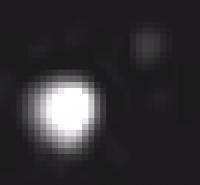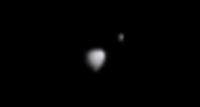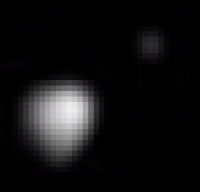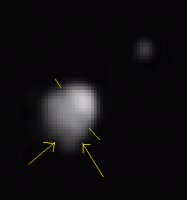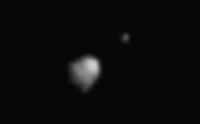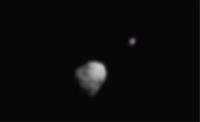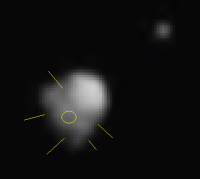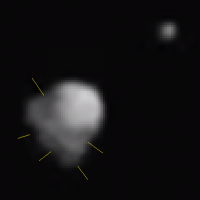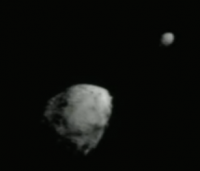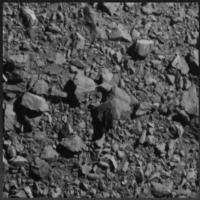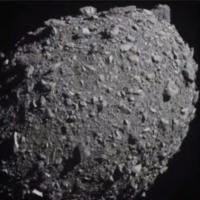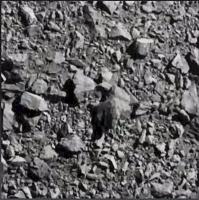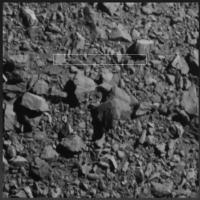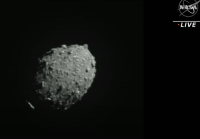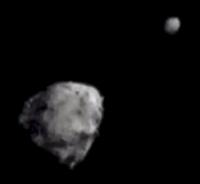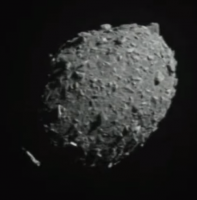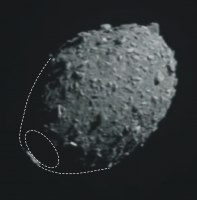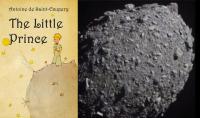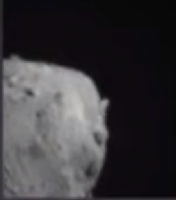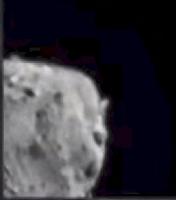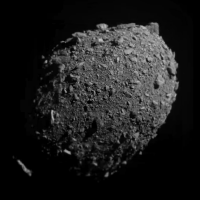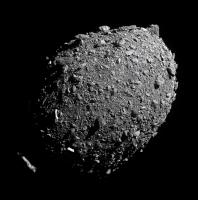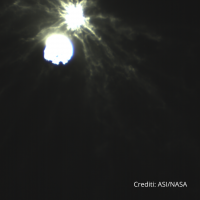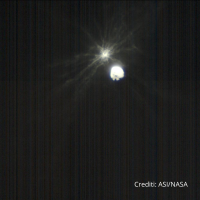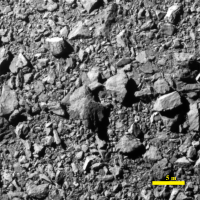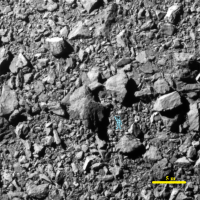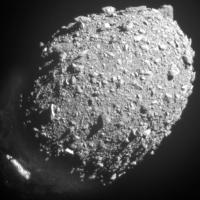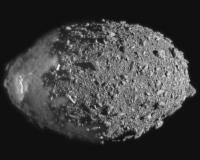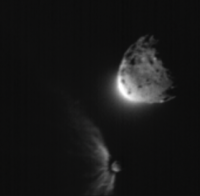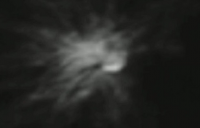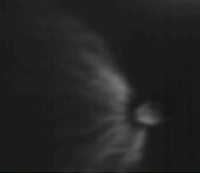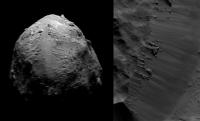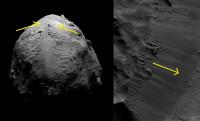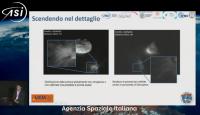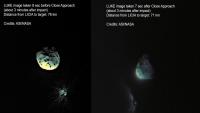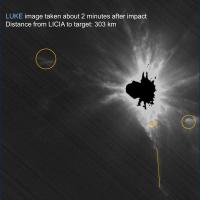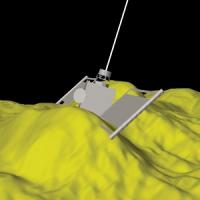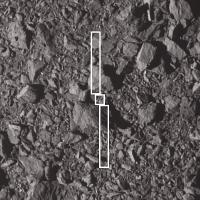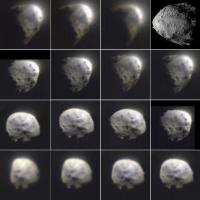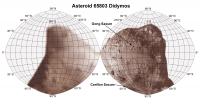Printable Version of Topic
Click here to view this topic in its original format
Unmanned Spaceflight.com _ Cometary and Asteroid Missions _ DART & HERA
Posted by: nprev Nov 24 2021, 07:27 AM
Surprised we didn't already have a thread. DART launched successfully at 0621 UTC today (23 Nov 21). https://www.nasa.gov/planetarydefense/dart, encounter (as in collision) with small satellite of 65803 Didymos in late Sep/early Oct 2022.
Posted by: Antdoghalo Nov 24 2021, 11:54 PM
Yay! We get to map two new objects for the price of one mission next September then try to blow one up as a cool experiment!
Posted by: Explorer1 Nov 25 2021, 12:15 AM
I remember watching Deep Impact live; what an experience, and finally to be replicated!
And of course, Hera will come after to survey the damage. It would have been nice for AIM to be funded and be there already as originally planned, but it's just as well, we really don't know how much debris will be produced, do we?
Posted by: JRehling Nov 25 2021, 02:14 AM
I had the thrilling good fortune to watch this launch from a (considerable) distance. It's quite an interesting mission… not really space "exploration" per se, at least in its primary intent.
Posted by: nprev Nov 25 2021, 03:43 AM
True, but we will get some science nevertheless, at least in terms of imagery. ![]()
Posted by: stevesliva Nov 25 2021, 04:18 AM
Reminds me a lot of DS-1 when I read the list of tech demonstrations on it at the JHUAPL site.
DS1 was more than 20 years ago...
Posted by: Marcin600 Nov 25 2021, 10:29 PM
From NASA Twitter: 55 minutes into its flight, the DART Mission spacecraft has separated from the SpaceX Falcon 9 second stage, and will soon begin to orient itself toward the Sun. - https://twitter.com/NASA/status/1463407550087503875 (nice video and goodbye to this spaceship forever)
Posted by: JohnVV Nov 26 2021, 12:42 AM
dose anyone have any news on any SPICE kernels for it's trajectory
we have ones for Lucy but what about DART
Posted by: Tom Tamlyn Nov 26 2021, 03:40 AM
I hadn't heard about Hera. It's an ESA mission to send a spacecraft to 65803 Didymos, the asteroid that Dart will crash into, and survey the damage. https://www.esa.int/Safety_Security/Hera
There's no thread for Hera on UMSF, but there are a few posts in the Unmanned Exploration Of Comets & Asteroids topic. http://www.unmannedspaceflight.com/index.php?showtopic=1951&hl=
NASA has an unrelated mission with the same name that doesn't involve robotic space exploration.
Posted by: TrappistPlanets Nov 26 2021, 01:31 PM
There's no thread for Hera on UMSF, but there are a few posts in the Unmanned Exploration Of Comets & Asteroids topic. http://www.unmannedspaceflight.com/index.php?showtopic=1951&hl=
NASA has an unrelated mission with the same name that doesn't involve robotic space exploration.
could we just also use this thread for Hera sense DART and Hera is going to the same double asteroid system? (question mainly for nprev)
Posted by: nprev Nov 26 2021, 09:13 PM
Good idea, since they are indeed closely related to each other. Thread title changed.
Posted by: monty python Nov 27 2021, 05:31 AM
So much international effort almost serendipitously focused on this asteroid makes me so happy.
I love it when a plan comes together!
Posted by: Explorer1 Nov 27 2021, 03:02 PM
I recall that Hera (originally called AIM) and DART had their orders reversed, but the lack of funding on the former by ESA for several years (until restoration and renaming to HERA) meant that DART will now be the initial scouting mission. Seems a bit of a reversal (shouldn't one characterize the Didymos system fully with a scientific mission before trying to alter it with a technology demonstration?) But this approach has its advantages; DART's onboard targeting will still allow it to catch Didymos, and there is no need to shelter an expensive scientific craft from a debris plume of unknown size. LICIACube will take plenty of spectacular images, I am sure!
Posted by: TrappistPlanets Nov 27 2021, 04:06 PM
what would be the highest resolution image possible of the asteroids?
Posted by: Floyd Nov 27 2021, 09:34 PM
I assume you mean images from the LICIACube. Google is your friend--good to develop the skill to answer your own questions. Lots of information on this satellite including the two cameras Leia and Luke. The most detailed information I've come across in in this https://www.hou.usra.edu/meetings/lpsc2021/pdf/2051.pdf
"LICIACube is equipped with two optical cameras (narrow and wide FoV) that allow acquiring significant images and evidence of the DART mission fulfillment. The primary instrument, named LEIA (Liciacube Explorer Imaging for Asteroid), is a catadioptric camera composed of two reflective elements and three refractive elements with a FoV of ± 2.06° on the sensor diagonal. The optic is designed to work in focus between 25 km and infinity and the detector is a monochromatic CMOS sensor with 2048x2048 pixel. The latter is equipped with a Panchromatic filters centered at 650nm±250nm. The primary camera will acquire pictures from a high distance providing high level of details of the frame field.
The secondary instrument, named LUKE (Liciacube Unit Key Explorer), is the Gecko imager from SCS space, a camera with an RGB Bayer pattern filter, designed to work in focus between 400 m to infinity. The sensor unit is designed to contain the image sensor interfacing with a NanoCU, while the optics consists of a ruggedized, mission configurable aperture, lens and required spectral filters. Moreover, the hardware is capable of directly integrating the image data to the integrated mass storage."
I'll let you do the math to find the resolution.
Posted by: TrappistPlanets Nov 28 2021, 12:17 PM
"LICIACube is equipped with two optical cameras (narrow and wide FoV) that allow acquiring significant images and evidence of the DART mission fulfillment. The primary instrument, named LEIA (Liciacube Explorer Imaging for Asteroid), is a catadioptric camera composed of two reflective elements and three refractive elements with a FoV of ± 2.06° on the sensor diagonal. The optic is designed to work in focus between 25 km and infinity and the detector is a monochromatic CMOS sensor with 2048x2048 pixel. The latter is equipped with a Panchromatic filters centered at 650nm±250nm. The primary camera will acquire pictures from a high distance providing high level of details of the frame field.
The secondary instrument, named LUKE (Liciacube Unit Key Explorer), is the Gecko imager from SCS space, a camera with an RGB Bayer pattern filter, designed to work in focus between 400 m to infinity. The sensor unit is designed to contain the image sensor interfacing with a NanoCU, while the optics consists of a ruggedized, mission configurable aperture, lens and required spectral filters. Moreover, the hardware is capable of directly integrating the image data to the integrated mass storage."
I'll let you do the math to find the resolution.
we could easily get a 4k or 8k texture map from those images
hopefully someone creates a shape model from the imagery (as radar meshes tend to not be fully correct, good example of this is toutatis), so i am able to properly reproject the stuff
Posted by: bobik Jul 20 2022, 08:16 AM
Nice https://iopscience.iop.org/article/10.3847/PSJ/ac6f52/pdf on ESA's Hera expedition.
Posted by: Explorer1 Sep 8 2022, 04:31 PM
https://www.nasa.gov/feature/dart-sets-sights-on-asteroid-target
Not much given they were from from late July, but new observations were taken in August as well (not released yet).
Two and a half weeks left, where did the time go?
Posted by: Explorer1 Sep 17 2022, 02:35 AM
https://www.nasa.gov/feature/dart-s-small-satellite-companion-takes-flight-ahead-of-impact
Posted by: Phil Stooke Sep 21 2022, 11:21 PM
https://twitter.com/JHUAPL/status/1572409029640716288
Jupiter!
Phil
Posted by: jasedm Sep 22 2022, 09:35 AM
Fascinated to see the results from this mission - 4 days to impact!
Posted by: Explorer1 Sep 22 2022, 02:03 PM
This brings me big memories of Deep Impact that summer of 2005, and watching the early webcasts (how quaint they were).
One of the press releases mentions LICIACube will take a few days to relay the plume images back, so it won't be quite the same in terms of immediate feedback, but still looking forward to it!
Posted by: jasedm Sep 26 2022, 06:18 PM
5 hours to go......
https://www.youtube.com/watch?v=vxImS5CYHwM
Posted by: Marcin600 Sep 26 2022, 09:13 PM
Live Feed from NASA's DART Spacecraft on Approach to Asteroid Dimorphos - in 17 minutes:
https://www.youtube.com/watch?v=-6Z1E0mW2ag
https://dart.jhuapl.edu/
Posted by: Explorer1 Sep 26 2022, 09:37 PM
Can't see the binary distinguished yet... but soon! Quite a bit of 'bouncing' for now.
Posted by: Hungry4info Sep 26 2022, 10:09 PM
On the stream they just mentioned that they're seeing Dimorphos now. So that might be real.
Posted by: Explorer1 Sep 26 2022, 10:28 PM
Target lock!
Didymos is already looking irregular now....
Posted by: Phil Stooke Sep 26 2022, 10:55 PM
Beginning to see possible structure on the terminator.
Phil
Posted by: Marcin600 Sep 26 2022, 10:56 PM
interesting shape, with a clearly protruding part at the bottom
Posted by: nprev Sep 26 2022, 10:56 PM
Precision lock achieved!!!
Posted by: Phil Stooke Sep 26 2022, 11:03 PM
A bit more detail. The protrusion will probably resolve into a big boulder.
Phil
Posted by: nprev Sep 26 2022, 11:18 PM
IMPACT.
Absolutely incredible terminal images.
Posted by: Explorer1 Sep 26 2022, 11:22 PM
Wow! Takes me back to 14 years old....
And that thin streak on the lower left (top of an enormous boulder, just barely in the Sun?)
Now we wait for LICIACube (and Hera, eventually)
Posted by: fredk Sep 26 2022, 11:37 PM
The final partial frame:
and it's approximate location in the previous frame:
Posted by: Tom O'Reilly Sep 26 2022, 11:40 PM
What is that light "bar" on the lower left side of Dimorphos? Present in multiple images, doesn't seem to be a camera artifact. Another object behind Dimorphos?
Posted by: CryptoEngineer Sep 26 2022, 11:40 PM
Strong vibes of 7 year old me watching Ranger 7 send photos as it crashed into the Moon in 1964.
Posted by: Explorer1 Sep 26 2022, 11:42 PM
Top of a huge boulder, mostly in shadow?
Press conference in about 15 minutes.
Posted by: Marcin600 Sep 26 2022, 11:44 PM
The illuminated rim of a relatively large crater (or some other depression).
For example like here:
Posted by: Hungry4info Sep 27 2022, 12:19 AM
Imaging of the DART impact plume from an Earth-based telescope.
Posted by: Explorer1 Sep 27 2022, 12:32 AM
Fascinating fact from the presser: looks like the ion engine would have been used in the case of a miss to hit Didymos 2 years from now for a second attempt!
Posted by: Marcin600 Sep 27 2022, 12:33 AM
It seems to me that fragments of Didymos's surface are a bit like Helene's surface - I see there a kind of fragmentary "surface crust" (???)
Posted by: Tom O'Reilly Sep 27 2022, 02:28 AM
For example like here:
Yes! That illustration is very clarifying.
Posted by: Phil Stooke Sep 27 2022, 03:36 AM
Nice view of the impact:
https://twitter.com/fallingstarIfA/status/1574583529731670021
Phil
Posted by: djellison Sep 27 2022, 06:25 AM
This is the best stack of images I could wrangle from the video at https://www.nasa.gov/feature/dart-s-final-images-prior-to-impact
Posted by: Phil Stooke Sep 27 2022, 06:36 AM
Since there are no other craters, I don't think the isolated bright object is a crater rim. More likely, I think, is a large rock sticking up into the sunlight. There was a very prominent rock on Itokawa like that. Explorer1 already suggested the same thing.
I hope we will be getting better versions of the primary asteroid images as well. It looks a bit like Itokawa with rough and smooth areas.
Phil
Posted by: monty python Sep 27 2022, 06:43 AM
Same here. Back then, hitting the moon with a working spacecraft was hard. We have come so far since then!
Posted by: Phil Stooke Sep 27 2022, 07:05 AM
I think Ranger 9 was the only one people actually got to watch.
https://sservi.nasa.gov/articles/live-video-from-ranger-9/
(the video link doesn't work on that site but it is on Youtube)
Phil
Posted by: Brian Swift Sep 27 2022, 07:34 AM
PNGs of a few images and downloadable 1080p video from pre-impact available from JHUAPL DART site
https://dart.jhuapl.edu/News-and-Resources/article.php?id=20220926
Don't know why there is horizontal flip between video and still images.
Posted by: xflare Sep 27 2022, 07:36 AM
That impact debris/plume sequence is extraordinary. Is that about what we expected to see? I wonder is Dimorphos is still in one piece
Posted by: Marcin600 Sep 27 2022, 08:30 AM
I hope we will be getting better versions of the primary asteroid images as well. It looks a bit like Itokawa with rough and smooth areas.
Phil
After looking at the enlarged fragment on the djellison's mosaic, now I also think it is an illuminated very large boulder on the surface - as Explorer1 suggested (you can see the texture of the rock)
Posted by: Marcin600 Sep 27 2022, 09:00 AM
https://www.nasa.gov/feature/dart-s-final-images-prior-to-impact
So it looks like the view from the impact video and all the frames pasted here are mirror-inverted
Posted by: john_s Sep 27 2022, 01:44 PM
I notice that the final partial frame appears somewhat out of focus. This makes sense because the frame width is apparently 16 meters and the telescope aperture is 0.21 meters, so the frame is only about 80 apertures wide. For a camera focused at infinity, the size of the focus spot should be equivalent to the aperture.
John
Posted by: Explorer1 Sep 27 2022, 02:21 PM
https://asitv.it/media/live
Posted by: tolis Sep 27 2022, 02:41 PM
Pictures!
Posted by: Explorer1 Sep 27 2022, 02:45 PM
Wow, those streamers, it looks quite catastrophic! Much more violent than the SCI on Ryugu, as expected!
Posted by: Marcin600 Sep 27 2022, 03:29 PM
pictures are for example here:
https://www.asi.it/2022/09/liciacube-conferenza-stampa-con-le-prime-immagini/
conference recording (on LICIACube results) - here:
https://asitv.it/contenuti/download/live/1ed3e75f-3f2f-69ae-8f47-63e163abba25/files
and here is video from the ATLAS telescopes:
https://www.youtube.com/watch?v=gaSXHVGCYZ8
Posted by: marsbug Sep 27 2022, 04:17 PM
John
Ah, I did wonder about that, thank you.
Posted by: vikingmars Sep 27 2022, 04:21 PM
Wow ! Yes: Dimorphos must be made of very loose material and may have been partially destroyed, if not entirely. We will see...
Posted by: mcaplinger Sep 27 2022, 05:04 PM
Regardless of what the images look like, that seems very unlikely, at least if you believe "Spacecraft Geometry Effects on Kinetic Impactor Missions", Owen et al, https://iopscience.iop.org/article/10.3847/PSJ/ac8932/pdf
However, they did a ton of work and then at the end
during the surface sampling in the OSIRIS-REx mission... that the weak material limit is
the most likely case. In fact, if Dimorphos’ surface is as weak
as that observed during the SCI experiment, it could be significantly
weaker than even the weak limit presented here.
I haven't read the paper in enough detail to know if their modeling is truly appropriate or just detailed but in an unrealistic way. But the spacecraft only had a mass of about 500 kg and Dimorphos is of order 10**7 more massive and DART wasn't going that fast.
On the other hand, I was thinking of this:
Han Solo: That's what I'm trying to tell you, kid; it ain't there... It's been totally blown away.
Posted by: marsbug Sep 27 2022, 05:38 PM
Looking at this picture: https://www.asi.it/wp-content/uploads/2022/09/6.png
The asteroid regolith is fairly dark material, but Didymos is quite over exposed. At the same time the streamers and debris, while widespread, are still barely visible, with no really bright spots except the one where the mini-moon itself is located. So the streamers are not dense, and don't have any larger chunks in (unless Dimorphos has a pure carbon interior), but the point where the mini moon sits is still bright - which suggests the moon itself is still dense and reflective compared to the streamers, and likely most of it is still in one place.
Posted by: Explorer1 Sep 27 2022, 07:05 PM
I think it's fair to say, however, there has been a not-insignificant loss of mass; a portion of the debris is on an escape trajectory, another portion will remain in orbit around Didymos, eventually impacting either body or escaping later on, and a portion will have settled back down or not been moved at all. I know there will be more LICIACube images to come (such as seeing the other side system!), but otherwise we will have to wait for HERA to figure out the ground truth of what 'We' just did, and the ratio of these portions, more exactly.
Posted by: Marcin600 Sep 27 2022, 07:31 PM
By the way, I added the scale indicators to this image: https://www.nasa.gov/sites/default/files/thumbnails/image/penultimate_dart_0401930049_43695_0.png
(based on the NASA description - width of the image is 31 m - to better visualize the size of what we see on the last full frame of Dimorphos):
these stones are really big ...
(difficult terrain for any eventual lander, rover or human explorer)
Posted by: vikingmars Sep 27 2022, 07:42 PM
However, they did a ton of work and then at the end
I haven't read the paper in enough detail to know if their modeling is truly appropriate or just detailed but in an unrealistic way. But the spacecraft only had a mass of about 500 kg and Dimorphos is of order 10**7 more massive and DART wasn't going that fast.
On the other hand, I was thinking of this:
Han Solo: That's what I'm trying to tell you, kid; it ain't there... It's been totally blown away.
Thank you very much for the paper : I went through it and, now, I'm convinced that Dimorphos has survived the impact and remains quite in good shape. The crater would be very visible and, maybe we will see some secondary impacts not only on Dimorphos, but also on Didymos as well. When the ESA spacecraft will reach the system in December 2026, there will be a lot of impressive images to be seen. Maybe some rocks were also thrown in orbit around Didymos by the impact, building some kind of 'secondary moons', making the system even more interesting to visit
Posted by: Explorer1 Sep 27 2022, 07:59 PM
Hopefully they won't be too big! OSIRIS-Rex sized pebbles are just fine, but big chunks are not a good idea! Though I am sure HERA will be well-prepared.
However, I think the gap in time is large enough for the area to clear naturally; Stardust certainly had no issues revisiting Tempel 1 after 6 years.
Posted by: fredk Sep 27 2022, 09:55 PM
My guess was also that it was extremely unlikely that Dimorphos could be destroyed. Then I did a spherical-cow/back-of-the-envelope calculation:
For mass 535 kg at 6.65 km/s, DART had kinetic energy of around 10^10 J.
For a radius of 80 m and density of around 1.86 g/cm^3 (as assumed in Owen etal), the gravitational binding energy of Dimorphos is -3/5 GM^2/R ~ -10^7 J.
So DART had ~1000 times as much kinetic energy as would be needed to completely disperse Dimorphos (ie to "rest at infinity"), ignoring any mechanical cohesion in the moon.
That was surprizingly high to me - I guess the point is gravity is weak and Dimorphos is small. Still, in reality that huge kinetic energy has to overcome mechanical cohesion and much of it will also go into heat, rather than overcoming gravitational potential energy. And of course much of the ejecta will greatly exceed escape velocity, so you're "overdispersing" a small amount of ejecta at the expense of "underdispersing" (or not dispersing at all) the rest.
So in the end the destruction (or not) of the moon is determined by the mechanical and thermal details, which presumably Owen etal have modeled sufficiently.
Posted by: mcaplinger Sep 27 2022, 10:23 PM
If you believe "REACTION OF DIMORPHOS' STRUCTURE TO THE DART IMPACT" https://www.hou.usra.edu/meetings/lpsc2021/pdf/2041.pdf then only 2.5e-3 of the kinetic energy isn't dissipated inelastically. That's still more than the gravitational binding energy, but I suspect the real system is a lot more complicated than any of these models. The whole concept of gravitational binding energy is somewhat abstract and ignores how the energy would be transported through the body, other sources of cohesion, etc.
TBH, I'm still not quite sure how this mission came to be or if it really tells us anything practical about how to deflect asteroids, but it was cool
Posted by: fredk Sep 28 2022, 12:28 AM
Indeed, as I mentioned this is a job for gory-details calculations. I did find it interesting and surprizing, though, that the one energy is ~1000 times the other.
My vague understanding of the justification of this was that the models vary by factors of order unity in predictions of the delta v imparted to the moon, due to the uncertainties in the mechanical properties etc, and they wanted to pin down those factors somewhat. I'd still worry that those factors might be significantly different for different asteroids, impact geometry, etc, so indeed it isn't clear what you've learnt...
Yeah, it was cool.
Posted by: StargazeInWonder Sep 28 2022, 03:46 AM
Given the above discussion, it may have been a missed opportunity not to have observed the other side of Dimorphos before the impact to check for effects at the antipode (or the location of any putative exit wound, if you will). If the asteroid is that loosely bound, it seems like the spacecraft drilling through the asteroid (or, still more likely, the spacecraft being embedded/destroyed and causing ejecta to leave the antipode) would be a more likely outcome than breaking the asteroid apart. But everyday intuition fails in a case like this, and the theory may not be much better.
Posted by: climber Sep 28 2022, 06:38 AM
Just imagine ending up with a ring
Posted by: climber Sep 28 2022, 07:02 AM
Very interesting hypothesis here : https://twitter.com/dr_thomasz/status/1574928508715143169?s=21&t=uhi9zu3uEVuWHohPUlr6YQ
Posted by: vikingmars Sep 28 2022, 11:37 AM
Thanks so much Climber: very interesting indeed
Posted by: Marcin600 Sep 28 2022, 05:17 PM
Here is a video compilation of 3 LICIACube pictures: https://twitter.com/i/status/1574784696311025664
Posted by: mcaplinger Sep 28 2022, 06:13 PM
One wonders if the large overexposure of the LICIACube images was intentional or accidental.
Posted by: Marcin600 Sep 28 2022, 06:17 PM
Rather intentional I think as the debris of the impact were expected to be faint (?)
EDIT:
According to David Avino, CEO of Argotec (in this article - https://www.repubblica.it/tecnologia/2022/09/27/news/impatto_con_lasteroide_le_prime_immagini_dalla_sonda_italiana_liciacube-367588148/ ) LICIACube took 620 pictures that will be downloaded in the next few days.
Posted by: StargazeInWonder Sep 28 2022, 06:41 PM
In a way, this continues the theme of Insight's failed drilling: While mechanics in space are incredibly predictable, mechanics in heterogeneous solid bodies are incredibly unpredictable.
Posted by: cIclops Sep 30 2022, 01:20 PM
https://dart.jhuapl.edu/News-and-Resources/article.php?id=20220929
Posted by: Quetzalcoatl Oct 2 2022, 02:17 PM
Hi,
A question arises. What is left of Dimorphos ?
Posted by: john_s Oct 2 2022, 06:28 PM
Despite the spectacular amount of debris, I've heard rough estimates of the total volume of ejected material being equivalent to a crater ten or so meters across, so Dimorphos is probably alive and well. We'll know soon, when mutual events are detected (or not...).
John
Posted by: scalbers Oct 2 2022, 06:32 PM
Yes this makes sense as my rule of thumb is a crater is around 20 times the diameter of the impactor.
Posted by: StargazeInWonder Oct 2 2022, 08:47 PM
The density and structure of Dimorphos makes it hard to compare with larger bodies with known impacts. This paper
https://academic.oup.com/mnras/article/515/2/2178/6634251
estimates a density of 2.2. Chondrites have a density of about 3.5, which would make Dimorphos about one third empty space. Lunar regolith is even less dense than that, but for any significant craters, the surface soil is an insignificant fraction of the volume. In a nutshell, there's probably, in comparison to the Moon, etc., more room (literally and figuratively) for Dimorphos's regolith to compress rather than eject, which could make a crater smaller, while creating a mascon of significant size compared to the entire body of the asteroid.
Posted by: Marcin600 Oct 3 2022, 06:45 PM
Something like "mini-panoramas" of the Dimorphos surface (unfortunately not very clear) - just for fun ![]()
From this picture: https://www.nasa.gov/sites/default/files/thumbnails/image/all_dimorphos_dart_0401930040_12262_01_iof_imagedisplay-final.png
Posted by: Phil Stooke Oct 4 2022, 06:38 AM
Nice mini-panoramas! But I noticed something in the image you linked to, and here I post it with some severe image brightening off the terminator... there is some detail to be seen in reflected light. The large boulder is reflecting light to its upper right in this view, clearly revealing a smaller boulder in shadow beneath it. There are other suggested details which might be picking up some light from Didymos - I think the geometry is correct for that. It will be interesting to see the raw data for these images, which might be more suitable for this kind of processing.
Phil
Posted by: Phil Stooke Oct 4 2022, 06:47 AM
Also... check out this wonderful family portrait by Roman Tkachenko:
https://twitter.com/_RomanTkachenko/status/1577016827993288704
Phil
Posted by: Phil Stooke Oct 4 2022, 07:22 PM
This is a better image of the night side of Dimorphos. There is lots to see. Too bad this won't work on Didymos, where there is no suitable light source.
Phil
Posted by: Marcin600 Oct 5 2022, 12:18 AM
Amazing work! So many new details from so few stray photons!
Dimorphos looks more elongated than I thought.
And this illuminated boulder is really huge - I estimate over 40 m long (the largest on this side of the moon).
[As for Roman's processing of pictures, I MUST say he has great talent]
Posted by: stevesliva Oct 5 2022, 01:56 AM
I vaguely recall hearing that another presscon was coming, with more LiciaCube images, with more scientific interpretation/results. Was I imagining that? Because I can't find anything to confirm that on the internets.
Posted by: Daniele_bianchino_Italy Oct 5 2022, 10:27 AM
So we wouldn't have more pictures of Didymos? :- /
I tried to compare Didymos ad DimorphoS with other recently visited asteroids:
Posted by: jasedm Oct 5 2022, 07:20 PM
That's a brilliant montage Daniele!, thanks for your time composing it
It's easy to forget that the reconnaissance of the asteroids in our solar system is fairly well-advanced these days. Psyche and Lucy will really add to our knowledge in the next decade.
I feel really lucky to be along for the ride in this era of discovery. On the year I was born (1967), we had some pretty decent images of the moon, and that was about it.
Posted by: Marcin600 Oct 10 2022, 04:47 PM
Media briefing at 2 p.m. EDT, Tuesday, Oct. 11 - https://www.nasa.gov/press-release/nasa-to-provide-update-on-dart-world-s-first-planetary-defense-test
As Italian Space Agency (ASI) President Giorgio Saccoccia will be among the participants of the briefing, I really hope to see some new pictures from LICIACube (and other pictures) ...
And maybe some new results from telescopic observations (?)
EDIT:
Tuesday, Oct. 11 at 20:00 Italian time - https://www.asi.it/2022/10/alla-conferenza-stampa-che-la-nasa-ha-convocato-per-martedi-11-ottobre-alle-ore-2000-italiane-ci-sara-anche-il-presidente-dellagenzia-spaziale-italiana-giorgio-saccoccia-per-parlare-della-m/
The conference will be broadcast live on the ASI TV website at: https://www.asitv.it/media/live
Posted by: john_s Oct 11 2022, 08:02 PM
I missed the briefing, but I see remarkable images like this one posted at https://www.nasa.gov/feature/nasa-dart-imagery-shows-changed-orbit-of-target-asteroid:
Is the bright limb on Didymos due to dust kicked up from the impact of ejecta from Dimorphos? Was this addressed in the briefing?
John
Posted by: Tom Tamlyn Oct 11 2022, 08:18 PM
I'll let you know when I've watched the whole briefing; I only caught the last third or so, and it wasn't mentioned during that portion.
The briefing video is here: https://www.youtube.com/watch?v=Zhzn0U2m5wQ&t=2352s
Posted by: mcaplinger Oct 11 2022, 09:02 PM
I didn't see the briefing, but this seems very unlikely. The exposure time of the images seems all over the place, I'm still not sure what the strategy being employed was.
Posted by: Hungry4info Oct 11 2022, 09:12 PM
My interpretation of that image is that we're seeing their night hemispheres, and that the bright part of Didymos' limb is the very tiny "crescent" of the asteroid that's in direct sunlight. The illumination of half of Didymos is coming from light reflecting off Dimorphos and scattering off the impact plume. The most convincing bit of evidence for this is the apparent shadowing of the impact plume by Dimorphos apparently centered around Dimorphos rather than angled off to the side.
Posted by: Explorer1 Oct 11 2022, 09:47 PM
Great new images; we can see a bit of the other side of Didymos too! Some enormous boulders on that side too (unless it's the same ones from a different angle)
Posted by: john_s Oct 11 2022, 10:16 PM
Hmmm.. not sure I buy that explanation. Dimorphos is displaced a long way "below" the line perpendicular to the apparent terminator on Didymos- if it was the source of the illumination, the terminator ought to be roughly perpendicular to the direction to Dimorphos. The bright "crescent" also looks rather too diffuse to be be sunlit portion, which should be vastly brighter than the Didymos+plume lit part. I agree the "hole" in the ejecta is peculiar, but it's not clear that it's easily explained as Dimorphos' shadow on the ejecta either, as the shadow should be the same size as Dimorphos.
I don't think dust kicked up on Didymos is an unlikely possibility- some of the ejecta is certainly going to hit Didymos at fairly high speed, and in zero g it could plausibly generate a lot of secondary dust.
We'll know more soon...
John
Posted by: Marcin600 Oct 11 2022, 10:56 PM
So:
1. DART slowed down Dimorphos by over half an hour - 32 minutes (although it was assumed that 10 minutes would be a success) and the tiny moon now orbits several dozen meters closer to Didymos
2. Dimorphos survived - it is still in one piece (against some fears) and ready for HERA's arrival ![]() :
:
Posted by: mcaplinger Oct 11 2022, 11:08 PM
We'll know more soon...
I don't think some dust being kicked up is unlikely, I guess, what I find less likely is that the bright areas are anything more than the bright low-phase edge of Didymos. At least based on the movie at the top of https://www.nasa.gov/feature/nasa-dart-imagery-shows-changed-orbit-of-target-asteroid
But I agree the outbound images look stranger than the inbound, so maybe you're right.
Not sure when we can expect to see the full LICIACube dataset.
Posted by: Marcin600 Oct 11 2022, 11:18 PM
"...LICIACube took a total of 627 images, 326 of which reached Earth. Once all the pictures have been received, they will become the subject of scientific research that will provide us with more information about the cloud resulting from the impact, and in particular characterize its structure and evolution..." - https://www.asi.it/2022/10/nasa-presenta-gli-ultimi-aggiornamenti-della-missione-dart/
Posted by: Hungry4info Oct 12 2022, 12:10 AM
The twitter user landru79 created a couple of animations from the available imagery https://twitter.com/landru79/status/1579925959708676097 and https://twitter.com/landru79/status/1579930045975789571 which show in splendid detail the 3D geometry of the system just after the time of impact. Truly glorious work, and enough to show that my interpretation of the images was quite wrong.
Posted by: john_s Oct 12 2022, 12:39 AM
Those animations are very instructive- thanks for the link! It really looks like the "anomalous" brightness of the Dimorphos-facing side of Didymos extends above the surface, consistent with it being due to kicked-up dust. Fascinating...
John
Posted by: Tom Tamlyn Oct 12 2022, 01:15 AM
John
Not addressed in the briefing. The LICIACube images were acknowledged and admired, but not analyzed.
Posted by: Daniele_bianchino_Italy Oct 13 2022, 09:50 AM
I tried to compare Didymos ad DimorphoS with other recently visited asteroids:
http://mondialieni.altervista.org/asteroid_asteroide_bennu_itokawa--ryugu-scale_lakdawalla_Bianchino.png
It's easy to forget that the reconnaissance of the asteroids in our solar system is fairly well-advanced these days. Psyche and Lucy will really add to our knowledge in the next decade.
I feel really lucky to be along for the ride in this era of discovery. On the year I was born (1967), we had some pretty decent images of the moon, and that was about it.
Many Thanks jasemd.
It's nice to Live these future and modern moments !! there will be others!
I wonder if a momentary ring of debris like Chariklo can form around the system! :-) or fantasy?
>,
Posted by: Gladstoner Oct 17 2022, 05:15 PM
Centrifugal scree 'slopes' on opposing hemispheres? Compared with talus features on Ceres:
Posted by: fredk Oct 20 2022, 10:35 PM
For a radius of 80 m and density of around 1.86 g/cm^3 (as assumed in Owen etal), the gravitational binding energy of Dimorphos is -3/5 GM^2/R ~ -10^7 J.
So DART had ~1000 times as much kinetic energy as would be needed to completely disperse Dimorphos (ie to "rest at infinity"), ignoring any mechanical cohesion in the moon.
One other relevant energy scale in the system is the orbital kinetic energy of Dimorphos. With a (pre-impact) orbital velocity of around 0.17 m/s and the above mass, I get around 6*10^7 J. So DART had roughly 200 times the KE that Dimorphos did. So it's not surprizing that DART could change the orbit significantly, subject to all the same caveats about dependence on mechanical properties of the moon etc. as we discussed above.
This suggests that impact may not be the most efficient way to perturb an asteroid, since only some small fraction of a percent of the KE of the impactor gets transfered to the asteroid; the rest going to heat and the ejecta. If time permits, perturbing instead with rocket engine burns (either sitting on the surface or via a gravitational tractor) may do better, and be more predictable, although of course such an engine needs to be sent to the asteroid and then slowed down to match its velocity, so it's not clear which would actually be more efficient.
Posted by: StargazeInWonder Oct 20 2022, 11:18 PM
It seems like it'd be more efficient than that to have a rocket full of fuel hit the asteroid and explode on contact, combining the kinetic energy of the craft with the chemical energy with the explosion. There's no need to make a nice, controlled burn that the rocket survives.
Posted by: nprev Oct 20 2022, 11:19 PM
In practical terms, this becomes a problem in terms of lead times & complexity even if compositional variables aren't considered. It would be difficult to built, test, and launch a powered redirect mission with a short lead time, but a DART-like impactor would be comparatively easy. In fact, building & storing (with ongoing maintenance & testing) a powered system for short-notice launch would be considerably more expensive than doing the same for an impactor mission.
Hard to say what, if anything, will eventually be decided here re an operational asteroid deflection system. But DART definitely provided a baseline set of interesting questions to ponder.
Posted by: mcaplinger Oct 21 2022, 12:49 AM
Oh, that must be why we just explode the fuel in a rocket instead of spending all that effort to build a complex rocket engine.
Seriously, you have to get the rocket exhaust to all go in the same direction at as high a velocity as possible for maximum efficiency.
Posted by: Bill Harris Oct 21 2022, 07:19 AM
Hubble is seeing a double tail around the Diddy-twins. A tail from the debris cloud could have been expected, but it seems that this tail and companion tail imply that there are active processes at work beyond the impact ejecta.
It will be interesting to see post-impact images from Hera.
https://hubblesite.org/contents/news-releases/2022/news-2022-056
Posted by: HSchirmer Oct 21 2022, 01:37 PM
Agreed; first thought is that a 'perturbation solution' would want a BDB (big-dumb-booster) that is a simple as possible-
Perhaps a SRB (solid rocket booster) filled with a nitrogen or ammonia ice that will sublimate at the temperature of the warm side of the asteroid (perhaps add solar panels and heaters to jump-start the process)
Posted by: mcaplinger Oct 21 2022, 07:23 PM
"Near-Earth Asteroid Deflection Strategies", by Dan Mazanek of NASA LRC, https://sservi.nasa.gov/wp-content/uploads/2014/05/AGC_2014_NEA_Deflection_Mazanek1.pdf is a good summary of various approaches. Direct propulsion is not the most effective according to this; short of nuclear weapons, kinetic impactors were judged the most effective.
Posted by: fredk Oct 21 2022, 10:23 PM
All of this is for the unlikely scenario that an object large enough to do serious damage is on course to collide soon. Objects large enough to make kilometre-sized craters are expected on intervals of thousands of years or longer, and the fraction of those that would hit densely populated areas is tiny.
It's still sensible to plan for those rare events, but likely we'll be in a very different regime for the next major strike: thousands of years from now we'll (hopefully) detect the objects well in advance with future surveys so there won't be any rush to launch an interceptor, and no disadvantage to the slower avoidance methods.
Posted by: Explorer1 Oct 22 2022, 04:21 AM
Even if less efficient (and considering the result last September, it seems quite effective!), multiple KIs could work just as well for more massive objects, just sending one after the other in a sequence (Shoemaker-Levy-9) style. One can separate the impacts by enough time for debris to dissipate to ensure the next one hits the target without running into (of course, a KI can be completely inert by the time it makes contact; as long as it has mass that's all that's needed).
(And I'm sure the PDCO and many others have already considered everything we discuss here anyway)
Posted by: Marcin600 Oct 24 2022, 07:09 PM
On October 27, 2022, a new ASI event will take place: „LICIACube, un mese dopo!” [LICIACube, one month later!]: https://www.asi.it/event/liciacube-un-mese-dopo/
„...One month after the DART LICIACube mission (...) ASI is organizing a public event to present the contribution of the Italian scientific community. The event will be held at the Auditorium of the ASI headquarters on October 27, 2022, at 10.00 (...) LICIACube is still downloading the acquired images, data storage and processing is managed in the Science Operations Center (SOC), at the Space Science Data Center (SSDC) of ASI...” [with agenda - in Italian]
Maybe we'll see some new images and / or interpretations???
Posted by: nprev Oct 26 2022, 08:25 AM
There's a case to be made for diverting smaller impactors down to Chelyabinsk-sized, though. Those demonstrably not only can cause extensive damage & injuries, they can also too easily be misinterpreted as military actions. Certainly long lead time detection & characterization of these smaller objects would mitigate the latter aspect, but it might be a good idea to be prepared to intercept them if they have a high probability of affecting a population center or other important/sensitive location.
Posted by: Marcin600 Oct 27 2022, 09:23 PM
The recording of the event is here: https://asitv.it/contenuti/download/live/1ed55f27-5744-6ef4-b6bc-e3793e2ef509/files/liciacube-un-mese-dopo
(only in Italian, no new pictures)
Some quotes from presentations:
The color of Didymos as seen by the LUKE camera is giallino = pale yellow
Characteristics of the plume:
- wide cone opening
- "filamentous" structure
- different distribution of speed and particle size
- deviation or overlapping of internal flows ("streamers") during the evolution of the plume
- morphology variable over time
And at 02:51:45 - nice clip of the OSIRIS-Rex touchdown video
Posted by: Explorer1 Nov 5 2022, 04:20 AM
Seven possible future targets for LICIACube being examined: https://pbs.twimg.com/media/FgEHo1jXwAE35_o?format=jpg&name=large
The closest one could be for next March (2000 YA) but 14827 Hypnos seems most exciting to me (a possible extinct comet). Obviously the cameras on LICIACube are not as good as DART's was, but it's always a good opportunity to use a perfectly functional spacecraft!
Posted by: Marcin600 Nov 5 2022, 08:34 PM
Yes, LICIACube has quite limited technological capabilities - we have to remember that this mini-satellite is about the size of a microwave oven, but the opportunity to "squeeze" more scientific results out of it is exciting!
BTW, there is a new potential opportunity to hear about the new LICIACube results from the Dimorphos impact observation:
Festival delle Scienze 2022 = Science Festival 2022, November 21, 08:00 - November 27, 17:00
https://www.asi.it/event/festival-delle-scienze-2022/
Saturday, November 26 at 19:00, Guest Room: "LiciaCube" conference:
„...A few months after the detachment of the LICIACube nanosatellite from the DART probe, the meeting will present the contribution of the Italian scientific community to the NASA mission at the Festival. A successful mission that opens up new perspectives in asteroid monitoring and exploration policies in the context of planetary defense...”
Posted by: bobik Nov 14 2022, 06:58 AM
An instructive https://az659834.vo.msecnd.net/eventsairwesteuprod/production-atpi-public/ad6af3cb5dbf4074ace7fdba20e15702 on the two Hera Cubesats and their integration with the Hera spacecraft.
Posted by: bobik Nov 22 2022, 07:55 AM
Reportedly, https://twitter.com/deepbluedot/status/1594461523971567617?cxt=HHwWgsDThd2T1aAsAAAA (Critical Design Review) last week. Though I am not fond of ESA's way and venue to communicate such important project milestones, the reply section of this tweet is somewhat funny. ![]()
Posted by: Marcin600 Dec 17 2022, 08:37 PM
AGU22: Press Conference "Pioneering Planetary Defense: What Comes Next After DART’s Asteroid Impact?" Decmber 15, 2022
https://www.youtube.com/watch?v=FF-5B7_FMfY
https://dart.jhuapl.edu/News-and-Resources/article.php?id=20221215
https://www.asi.it/2022/12/un-prestigioso-riconoscimento-per-dart/
Some quotes from the presentations given at the press conference:
Andy Rivkin (DART Investigation Team Lead, Johns Hopkins Applied Physics Laboratory)
"...An estimate of how much material was blasted off of Dimorphos by DART and we think it is about a million kilograms of material at the least. So this is enough to fill six or seven railway cars of gravel (...) This number is a minimum, it could be twice that, it could even be as much as 10 times that according to same estimates..."
Cristina Thomas (DART Observations Workin Group Lead, Northern Arizona University):
"...The two spectra [of Dimorphos and Didymos] looked very similar. Thay have a lot of these consistent features (...) which are consistent with it being an analog for something like an ordinary chondrite (...) So, we see that these two objects [Dimorphos and Didymos] are in fact similar in composition. You'll notice that there are some slight differences that are tied to a lot of other questions that we are going to be investigating in the coming months, but they do not actually impact the way that we think about it compositionally..."
Alessandro Rossi (LICIACube Science Team Member, Instituto di Fisica Applicata Nello Carrara):
"...[LICIACube] startet science operations 71 seconds before impact (...), [and was] 58 km from the system at closest approche...
...Enhanced color images: the left one was taken about 3 minutes after the impact, (...) we are looking at the south pole of Didymos and you see the ejecta cloud almost face on. A few seconds after LICIACube has moved and we see the plume from a different perspective and we clearly notice the cone shape of the ejecta coming out of the surface of Dimorphos and we also can notice a kind of dark arc over the surface of Dimorphos which we believe is related to the shadow of the plume itself on the surface of Dimorphos....
...We can enhance the level of saturation of the images and it is in this image you see the saturated part of the image in black, but in that way other features of the ejecta plume come to your vision, and here we clearly see some very interesting structure in the ejecta plume. You see linear filaments of material being ejected from the surface, but we also see clumps of materials possibly related to agglomerates of two particles in the process of being disrupted and also nodules that we attribute to the presence of larger boulder being ejected. Take a looking at images at different times we can be able to compute the velocities of these objects, which we count on the order of tens of meters per second in these cases..."
Andy Cheng (DART Investigation Team Lead, Johns Hopkins Applied Physics Laboratory) - on the results of momentum transfer calculations
Credit: ASI/NASA
EDIT: I replaced the second picture with a better quality one - officially published on the NASA website (but with a wrong description, which concerns the first picture, not published there by NASA): https://www.nasa.gov/feature/imagery-of-early-results-from-nasa-s-dart-mission
The yellow circles indicate: "two clumps of materials possibly related to agglomerates of two particles in the process of being disrupted" and two possibly "larger boulders being ejected".
Posted by: Hungry4info Jan 27 2023, 11:06 PM
Some surface features on Dimorphos have been assigned names, with the theme being drums from various cultures.
Drums because we hit the asteroid ... get it?
https://planetarynames.wr.usgs.gov/Page/DIMORPHOS/target
Posted by: fredk Mar 3 2023, 12:19 AM
Some results published in https://www.nature.com/articles/d41586-023-00601-4 One number reported is that the momentum imparted to Dimorphos was around 4 times that of DART, due to the ejecta.
Repeating this calculation for momentum, the ratio is flipped right around, due to the different dependences on velocity. I find the momentum of Dimorphos to be around 7*10^8 kg m/s. around 200 times DART's momentum of 3.6*10^6 kg m/s. Momemtum isn't subject to uncertain losses do to heating etc, just to what the ejecta carries, so this is a better measure than KE of what effect you'd expect DART to have on the moon's orbit. 1 in 200, or 4 in 200, sounds about right.
Posted by: Marcin600 Mar 3 2023, 06:32 PM
And https://www.nasa.gov/feature/nasa-s-dart-data-validates-kinetic-impact-as-planetary-defense-method and https://dart.jhuapl.edu/News-and-Resources/article.php?id=20230301 is a model showing the DART's alignment as it hits the surface of Dimorphos
"...the spacecraft body hit between two large boulders while its two solar panels impacted those boulders..."
Credits: NASA/Johns Hopkins APL
Posted by: Tom Tamlyn Apr 21 2023, 05:15 PM
Nature has published a cover story about DART, with five open access papers.
https://www.nature.com/nature/volumes/616/issues/7957
Although currently there is no known threat to Earth from asteroids, strategies to protect the planet from a collision are being explored. On 26 September 2022, NASA and the Johns Hopkins Applied Physics Laboratory successfully tested one such approach: the Double Asteroid Redirection Test (DART) spacecraft was deliberately crashed into Dimorphos, a moon orbiting the small asteroid Didymos, resulting in a change in the moon’s orbit. In this week’s issue, five papers explore the test and the effects of the collision. One paper reconstructs the impact; a second looks at the change to Dimorphos’s orbit caused by the impact. A third paper reports observations from the Hubble Space Telescope of the material ejected during the collision. A fourth paper uses modelling to characterize the transfer of momentum that resulted from the impact. And the final paper reports on citizen science observations before, during and after the collision.
H/t to Shannon Cofield @MarsRoverMapper, who tweeted the link.
Posted by: Phil Stooke Nov 15 2023, 04:14 AM
I have made a set of LICIAcube images of Didymos (plus one from DART itself). All LICIAcube images are from ASI.
The sequence starts at bottom left and moves to the right, then up a row and to the right again.
Also an image pair showing common features between the DART and best LICIAcube images (latter showing the south polar area)
Phil
Posted by: Marcin600 Dec 9 2023, 03:45 PM
I missed this post, but I have to comment on this...
Great job Phil, this is a fantastic and very informative "mini-atlas" of Didymos!!!
While waiting for HERA (and that's still at least 3 years), this is the most complete overall picture of this body. Thanks for that!
I don't know why NASA (and ASI) doesn't do and publish things like this - after all, it is part of the legacy of this mission...
Posted by: Phil Stooke Dec 10 2023, 07:36 AM
Thanks! It's really the mission teams that should get on this, not the agencies. It would only take a willing grad student with access to the images.
Phil
Posted by: Phil Stooke Feb 12 2024, 09:40 PM
Here is an experimental map of Didymos, made for my LPSC poster. The coordinates are from a preprint by Barnouin et al.:
https://www.researchsquare.com/article/rs-3399230/v1
Two names were recently added.
Phil
Posted by: bobik Feb 25 2024, 02:12 PM
Interesting, the opto-mechanical design of the https://www.youtube.com/watch?v=fDhfPyl92SU&t=161s of Hera's https://az659834.vo.msecnd.net/eventsairwesteuprod/production-atpi-public/2d8d49fa68204ff9a35da4240d816a49 (p. 13bl) instrument seems to be quite different to the https://iopscience.iop.org/article/10.1088/1757-899X/1226/1/012094/pdf. ![]() EDIT: Apparently, for some unknown reason, they changed the altimeter to a serial-produced https://www.jenoptik.com/products/lasers/laser-distance-sensors/dlem from Jenoptik.
EDIT: Apparently, for some unknown reason, they changed the altimeter to a serial-produced https://www.jenoptik.com/products/lasers/laser-distance-sensors/dlem from Jenoptik.
Powered by Invision Power Board (http://www.invisionboard.com)
© Invision Power Services (http://www.invisionpower.com)

